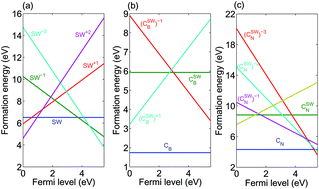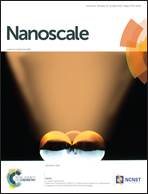Local charge states in hexagonal boron nitride with Stone–Wales defects
Abstract
A Stone–Wales (SW) defect is the simplest topological defect in graphene-like materials and can be potentially employed to design electronic devices . In this paper, we have systematically investigated the formation, structural, and electronic properties of the neutral and charged SW defects in hexagonal boron nitride (BN) using first-principles calculations. The transition states and energy barrier for the formation of SW defects demonstrate that the defected BN is stable. Our calculations show that there are two in-gap defect levels, which originate from the asymmetrical pentagon–heptagon pairs. The local defect configurations and electronic properties are sensitive to their charge states induced by the defect levels. The electronic band structures show that the negative and positive charged defects are mainly determined by shifting the conduction band minimum (CBM) and valence band maximum (VBM) respectively, and the SW-defected BN can realize −1 and +1 spin-polarized charge states. The effects of carbon (C) substitution on neutral and charged SW-defected BN have also been studied. Our results indicate that the C substitution of B in BN is in favour of the formation of SW defects. Structural and electronic calculations show rich charge-dependent properties of C substitutions in SW-defected BN, thus our theoretical study is important for various applications in the design of BN nanostructure-based devices.


 Please wait while we load your content...
Please wait while we load your content...